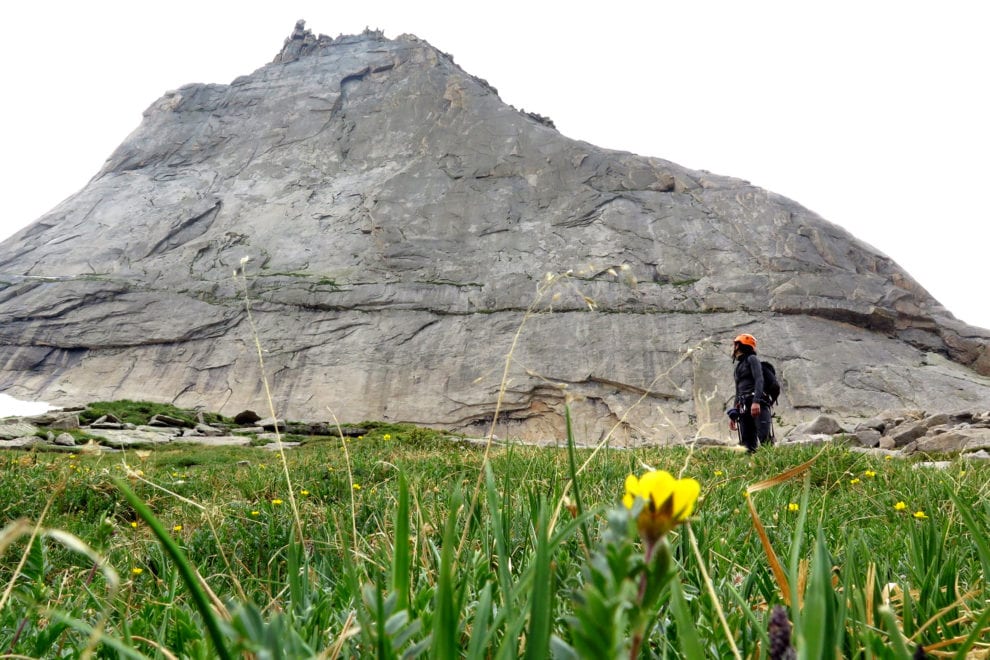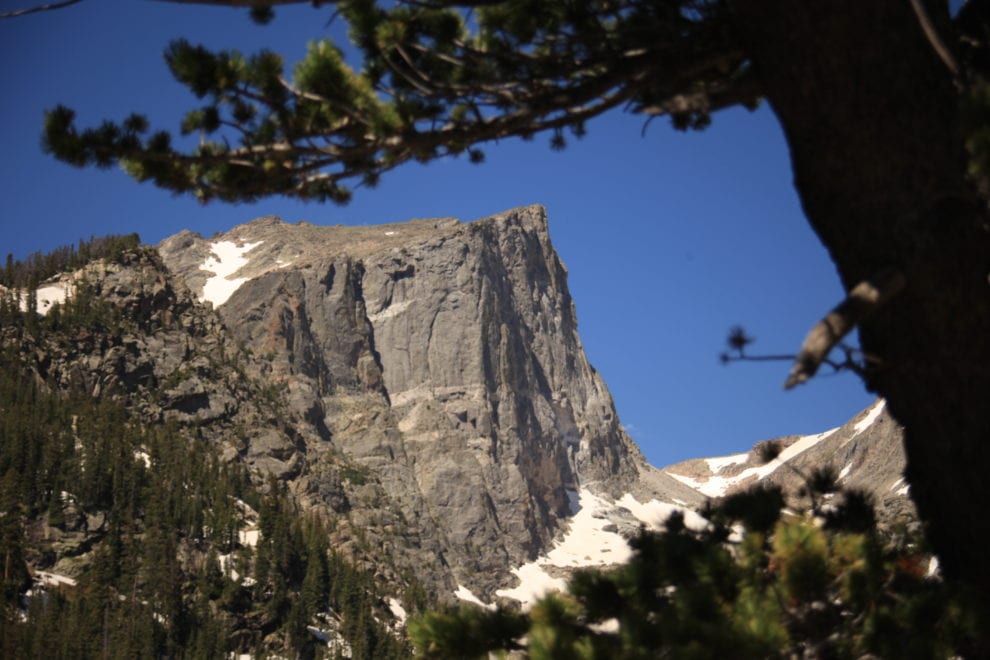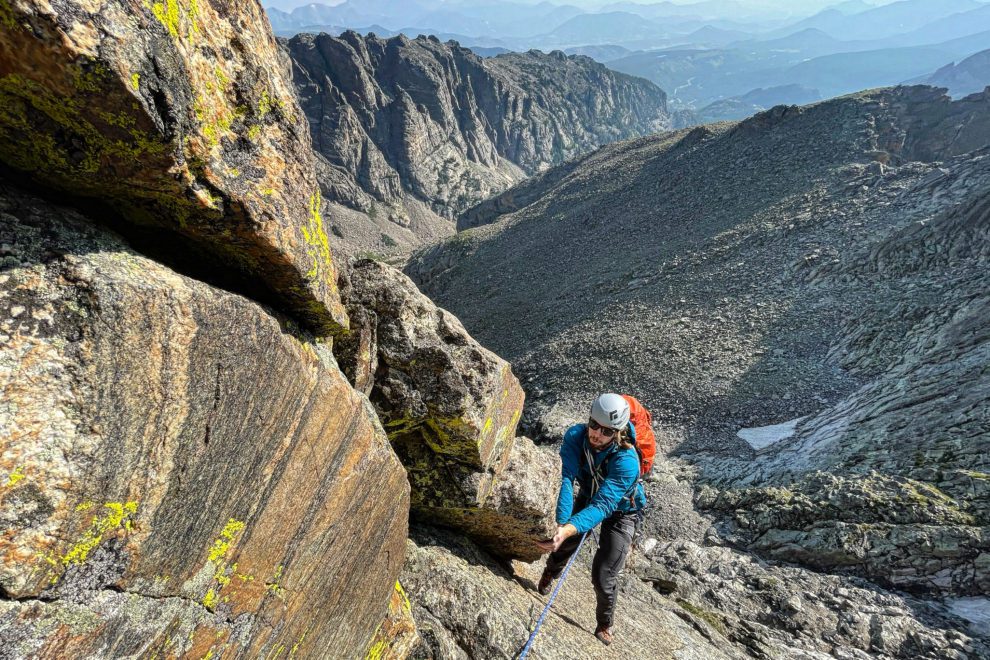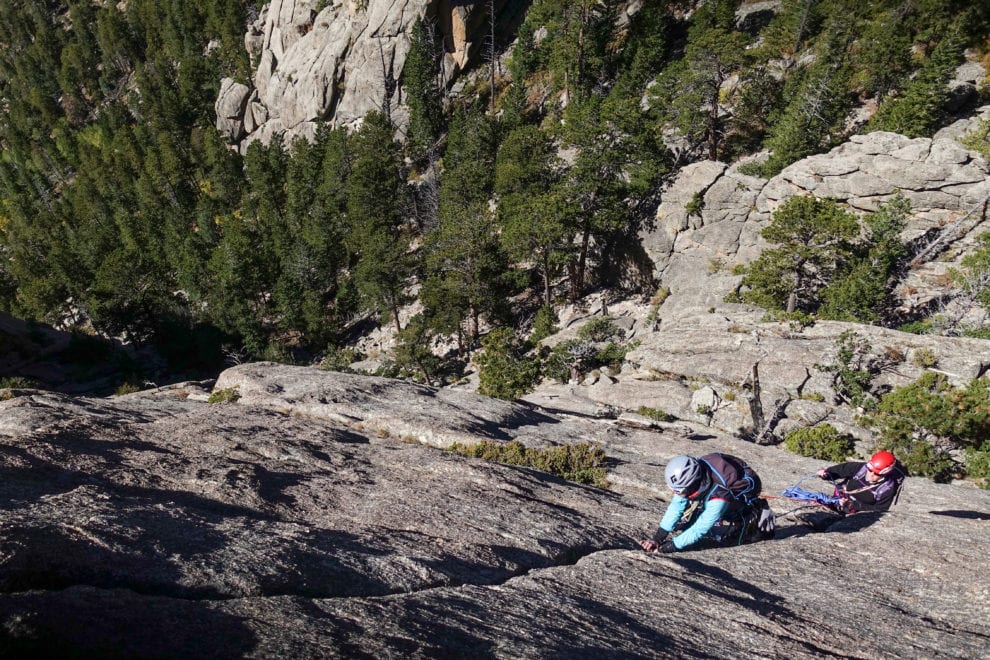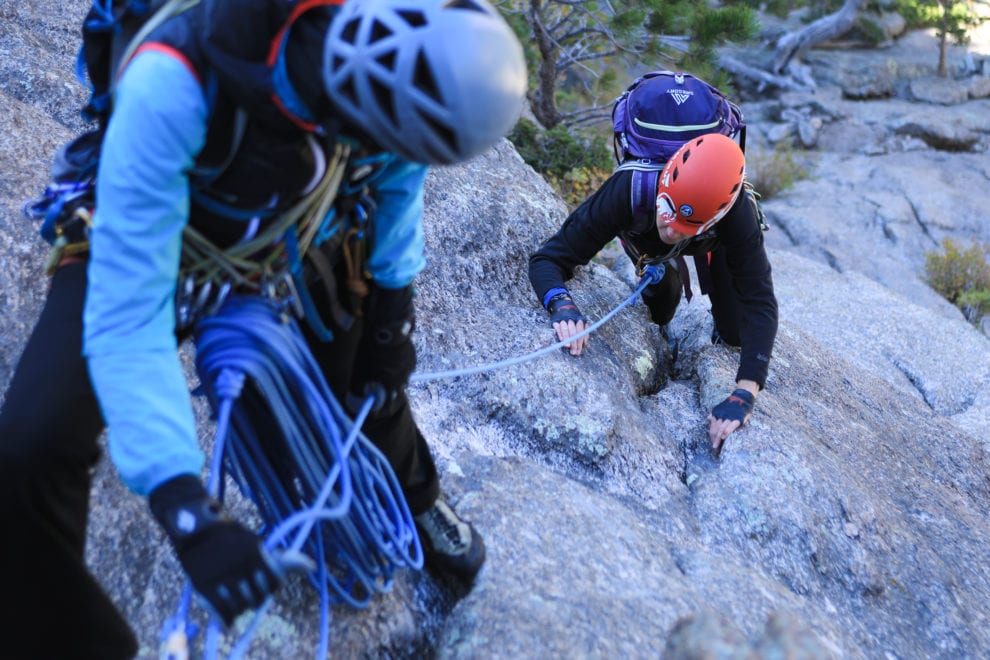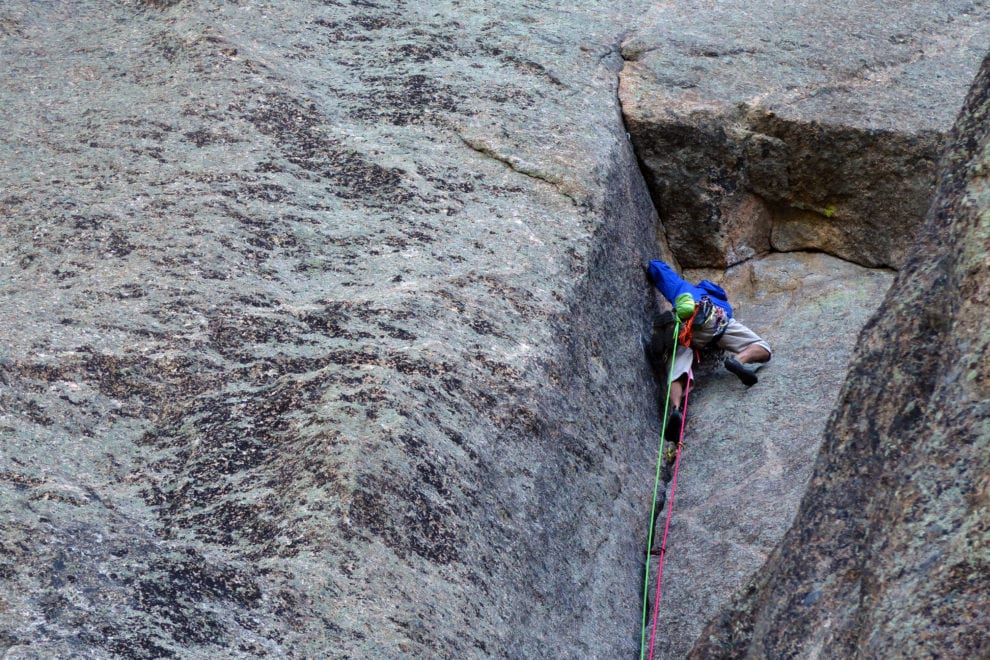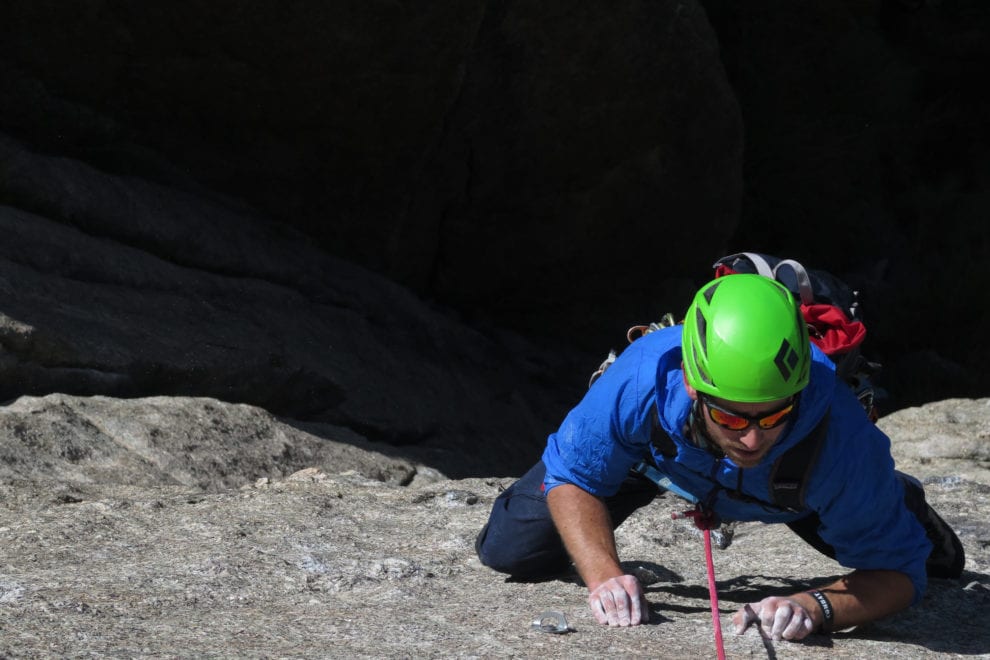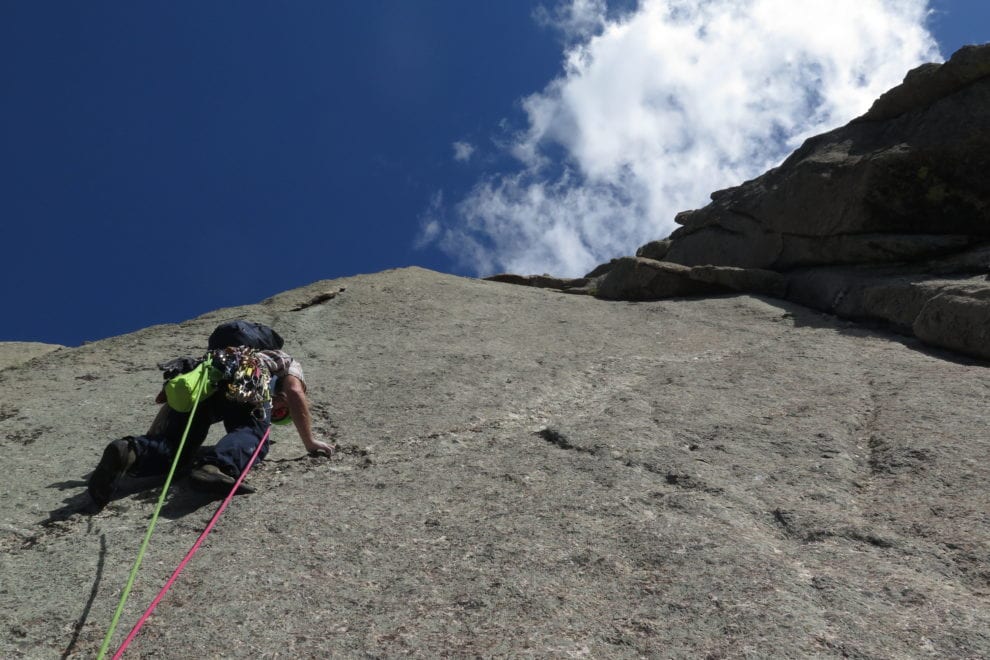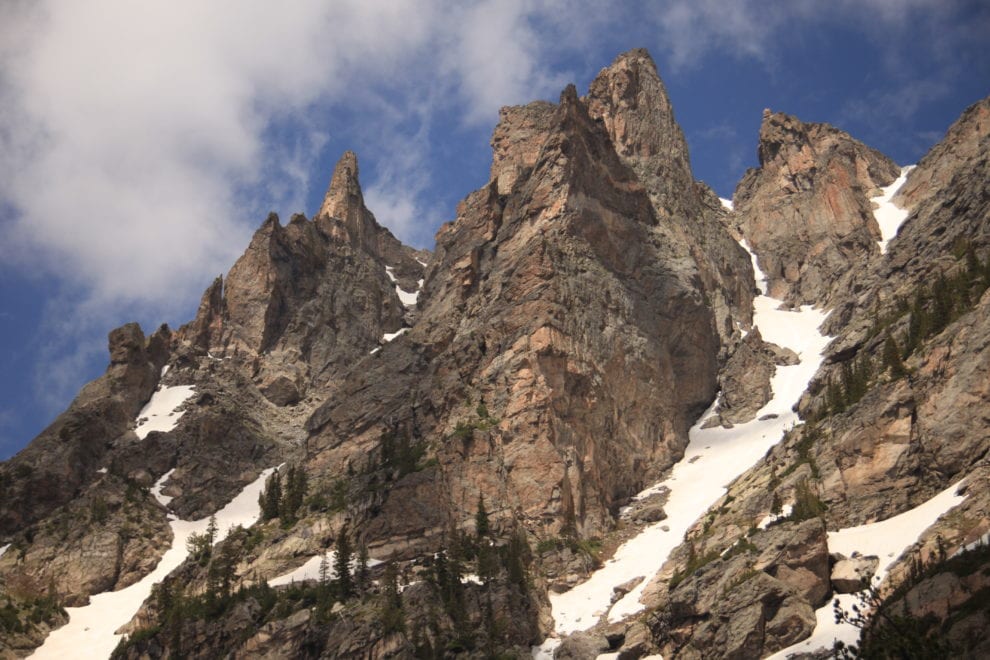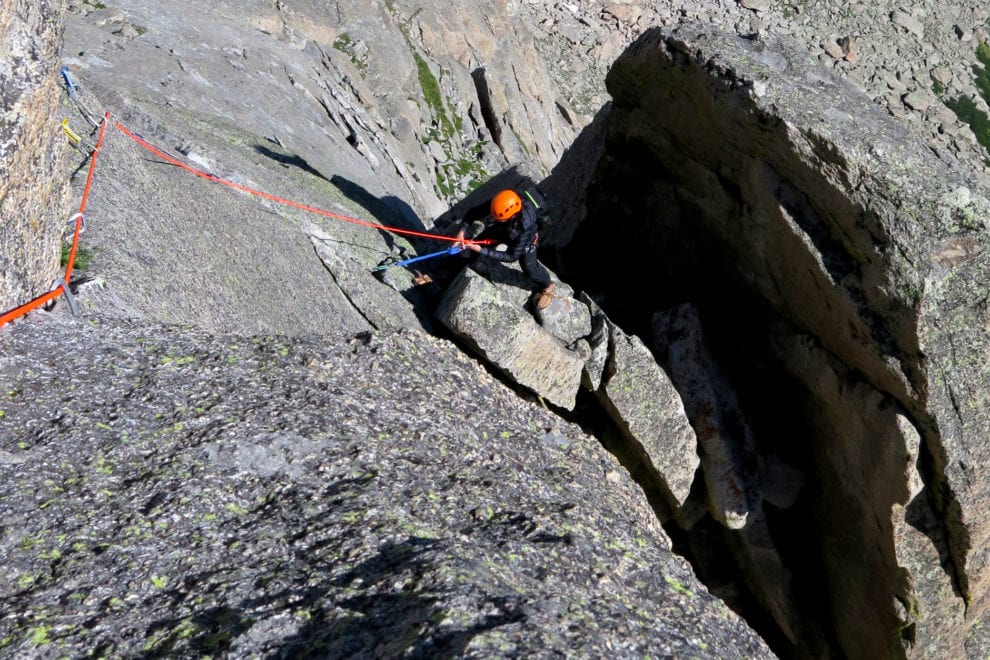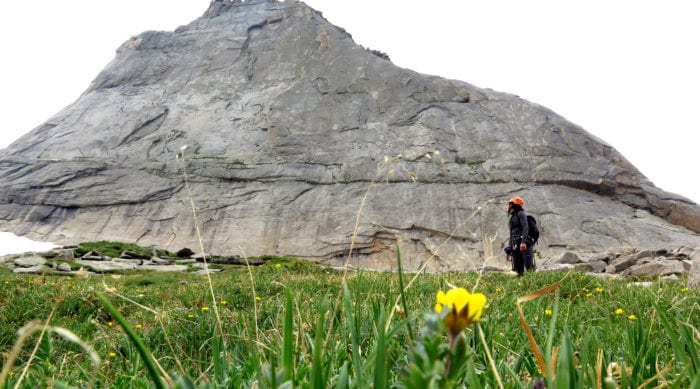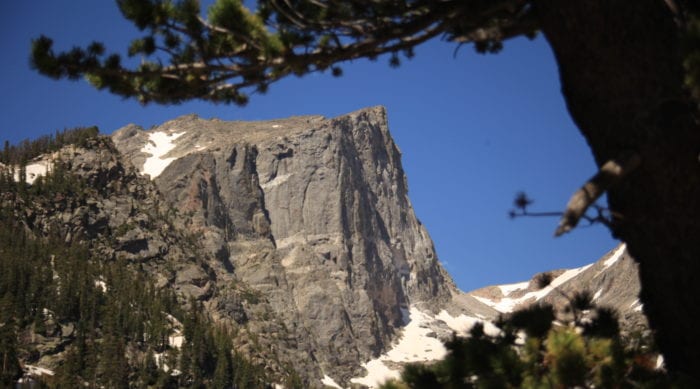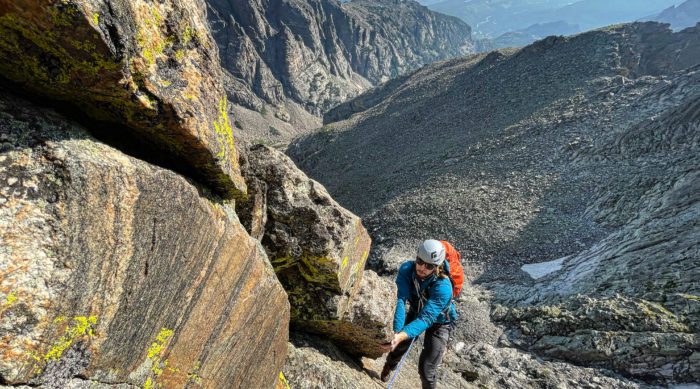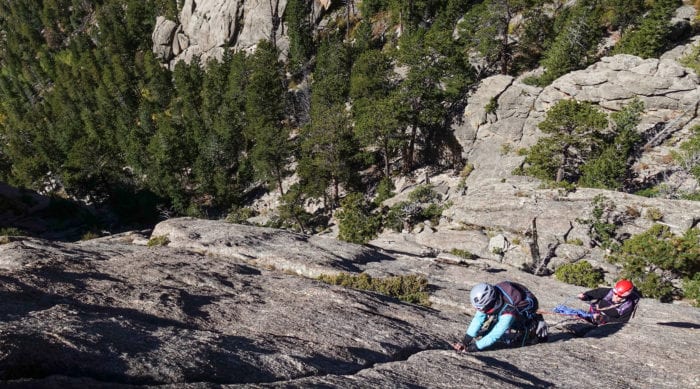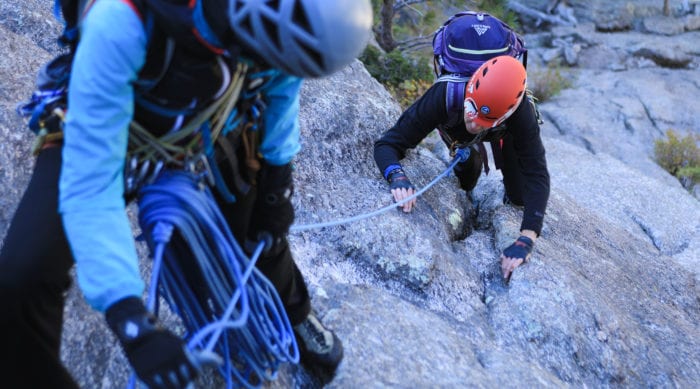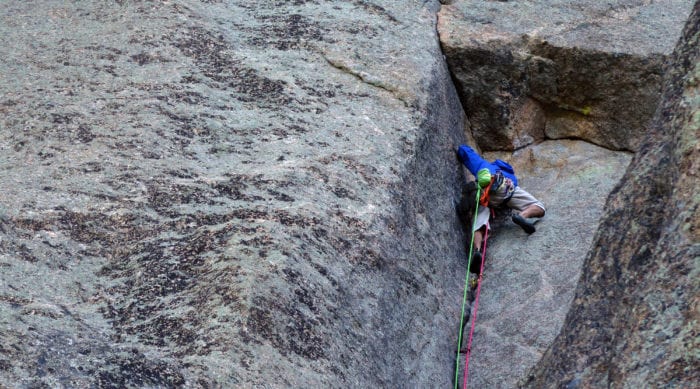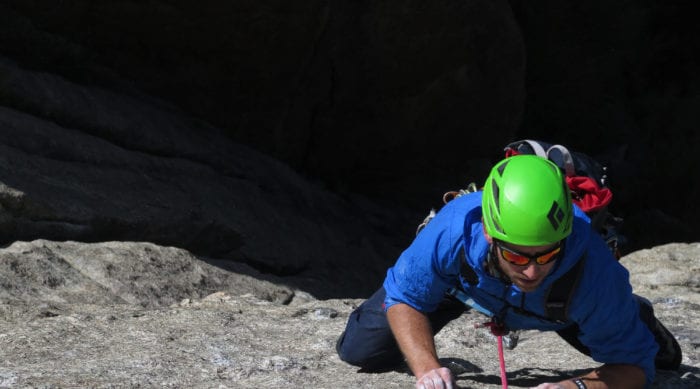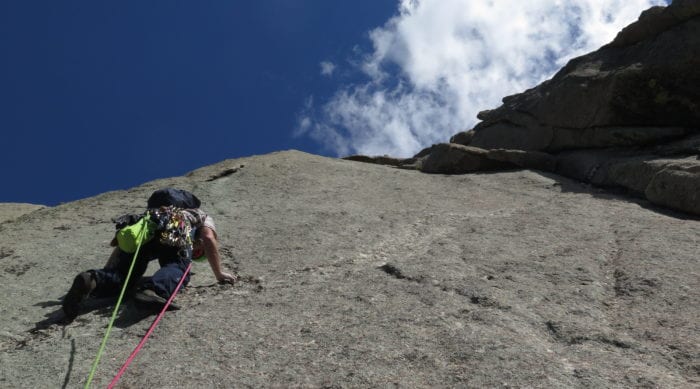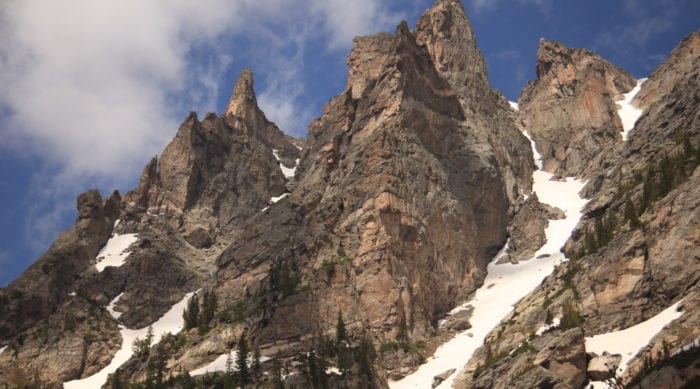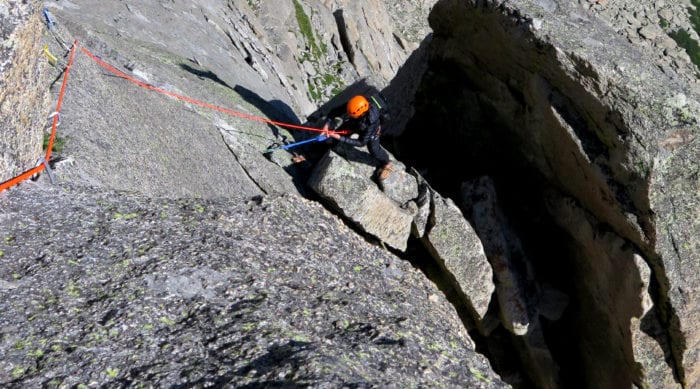- Photo by: Colin Wann

- Photo by: Colin Wann

- Photo by: Woody Lowder

- Photo by: Colin Wann

- Photo by: Colin Wann

- Photo by: Colin Wann

- Photo by: Colin Wann

- Photo by: Colin Wann

- Photo by: Colin Wann

- Photo by: Colin Wann

Overview
Rocky Mountain National Park offers some of the best climbing in the country, attracting avid climbers from around the world. With unrivaled views of the Continental Divide, great weather and beautiful rock, it’s hard to beat. The Mountain Guides Colorado offers a wide variety of climbing adventures. From alpine multi-pitch rock routes to snow filled couloirs and everything in between, there’s something for everyone. Routes like the Spiral Route on Notchtop are great for beginners looking to get more experience in the alpine and routes like the Casual Route for folks looking to truly test themself in the vertical environment. Rocky Mountain National Park has something for anyone looking to explore what adventures the mountains have to offer.
While most trips will only require one day, some of these bucket-list summits will require an overnight to complete. Most climbs require prior multi-pitch experience.
Types Mountaineering - Multi Day Trips - Rock Climbing - Single Day Trips
Season Spring, Summer, Fall
Elevation 10,000-14,000 feet
Minimum Age 12
Trip Planner
Itinerary
Rocky Mountain National Park offers unparalleled alpine climbing objectives, often requiring a very early start with complex navigation made infinitely easier and safer with the use of a guide. After the adventure of finding the route in the early morning hours, prepare to gain increasingly impressive vistas of the Park’s topography, including the Continental Divide. An overnight approach may be required or preferred for certain routes. Prior climbing experience or prerequisite instruction is required.
Hallett Peak: The North face of Hallet Peak is located above Emerald Lake in the spectacular Tyndall Gorge. This face offers classic moderate routes like the unforgettable Culp-Bossier 5.8+ grade III, known for its inclusion in the infamous 50 Classic Climbs of North America book. For a slightly less technical challenge, one may also choose the fantastic Hallett Chimney 5.6 grade III. Hallett Peak is one of the more popular summertime objectives as it offers one of the shortest approaches in the park.
Sharkstooth: Located in the Cathedral Spires group near Andrews Glacier, Sharkstooth is one the highest and most aesthetic summits Rocky Mountain National Park has to offer. With a stunning 12,630′ summit near the Continental Divide, this alpine climb allows access to its views via the classic NE Ridge 5.6 grade III. For those looking to summit and forego the more technical climbing, the East Gully 5.4 is an easier and quicker option to reach Sharkstooth magnificent pointed summit.
Petit Grepon: Another classic rock feature in the Cathedral Spires group sits the Petit Grepon. A few routes exist on this narrow pillar of rock, but none more classic than the South Face 5.8 grade III as it is one of the three routes in the park that are in the infamous 50 Classic Climbs of North America book. Unlike its towering neighbor, the Sharkstooth, the Petit Grepon is accessed via Sky Pond. Once the magnificent summit the size of a dining table is reached, the adventure does not stop there. The descent includes 6 steep and exciting rappels back to the base of the climb.
Spearhead: Nestled in the upper reaches of Glacier Gorge far from the busy trailhead, a beautiful fin of perfect granite exists called Spearhead. The formation is surrounded by some of the most impressive peaks in the Park, including Longs Peak and its serrated SW ridge-line. Spearhead contains a variety of routes such as the more technical The Barb 5.10b grade III, and Sykes Sickle 5.10a grade III, to the classic North Ridge 5.6 grade III. No matter the route, Spearhead provides one of the more memorable objectives as it tops out on its spire featured summit.
Notchtop: At 12,159′, Notchtop offers some of the most unique climbing in the park. With a reasonably short approach, Notchtop is one of the more seldom climbed peaks for its proximity to the trailhead. Boasting a variety of routes such as the Spiral Route 5.4 grade III, to the South Ridge 5.9, grade III, Notchtop has something for everyone.
Duration: 8-12 Hours car to car beginning between 2:00am-5:00am. Multi day overnight options are available at an additional charge.
Some of Rocky Mountain National Parks classic climbs are father and more complex requiring longer days. Attempting to climb some of these more demanding and challenging routes will require a much earlier start by headlamp or perhaps an overnight approach to reach the objective in a timely manner. These climbs are not always the most technically difficult, but require more time to achieve. An overnight approach may be required or preferred for certain routes. Prior climbing experience or prerequisite instruction is required.
The Diamond: The Diamond is the world famous East face of Longs Peak. Its sheer and prominent wall boasts some of the more technically challenging routes in Rocky Mountain National Park, the Casual Route 5.10a grade IV, being one of them. Don’t be fooled by the name, the Casual Route is sustained and committing and is one of the parks three routes in the infamous 50 Classic Climbs of North America book.
Mt Yipson: Mt Yipson is a lesser traveled mountain in Rocky Mountain National Park. For those looking for a remote and slightly less technical climb, Blitzen Ridge 5.4 grade IV delivers with its impressive and aesthetic knife like ridge-line. Going at a modest 5.4 rating, navigating the exposed four aces will still provide plenty of adventure.
Kieners: Longs Peak has hundreds of routes that reach its summit, but perhaps none more classic than Kieners 4th class, steep snow, grade IV. Kieners is unique in that it requires multiple skill sets including snow travel and rock climbing. Ascending from Chasm Lake, one must first climb Lambslide Couloir requiring steep snow technique using ice axe and crampons. Next is broadway ledge with easy but very exposed scrambling to reach the base of Kieners. Then it is an adventurous 4th class scramble to the summit.
Notch Couloir: Similar to Kieners, the Notch Couloir steep snow AI2+ M3 grade IV, requires a combination of skills. Navigating snow, rock, and ice, one must be prepared for anything when attempting this aesthetic couloir climb hiding next to Longs Peak’s famous Diamond Face.
Duration: 12+ Hours Car to Car beginning between 12:00am- 2:00am. Multi day overnight options are available at an additional charge.
Pricing
RMNP Alpine Climbing Level 1 $665* 1 person, $525* 2 people, $445* 3+ people
RMNP Alpine Climbing Level 2 $845* 1 person, $595* 2 people
Non-Technical Day (Multi Day Approach/Egress) $545* 1 person, $345* 2 people, $285* 3+ people
Overnight $110* 1 person, $85* 2 people, $70* 3 people*
Price per person, per day, per night.
Ask about our discounted “Speed Bivy” option for overnight trips. (Previous multi pitch climbing experience required)
Please fill out the inquiry form to request a trip. Please read through our policies by visiting this page.
Equipment
For your safety and comfort, bring synthetic and or natural fiber clothing for insulation. Cotton is NOT recommended and down must be kept dry. Clothing should be able to layer without encumbering your movement.
Footwear
Objective Dependent – Scarpa footwear is available at Jackson Hole Mountain Guides for rent. JHMG also carries a selection of rock shoes for rent.
- Sticky Rubber Approach Shoes: required for all mid-summer climbs (mid-July through Sept). Guide Pick: Scarpa Crux (Available for rent)
OR
- Mountain Boots: Trips before July 15, require a crampon-compatible mountain boot. Guide Pick: Scarpa Zodiac Tech (Available for rent)
- Rock Shoes for technical rock routes (Available for rent)
Upper Layers
- Synthetic/Wool Long Underwear Top
OR
- Synthetic/ Wool Sun Hoody – Guide Pick: Mountain Hardwear Crater Lake Hoody
- Synthetic T-shirt
- Insulating Jacket: lightweight fleece or synthetic
- Soft Shell: fleece or pile
- Rain Jacket: waterproof/breathable with hood.
Bottom Layers
- Synthetic/Wool Long Underwear Bottom
- Hiking Shorts
- Synthetic Climbing Pant
- Rain Pant
Accessories
- Hat: lightweight to medium weight warm hat – sleek enough to be worn under a helmet
- Gloves: one lightweight to medium weight pair – synthetic or fleece material. If snow route, shell also recommended.
On the Trail
- Back Pack: internal frame 30 Liter capacity (2000 cu in)
- Water Bottles (2-3 L/Qt.) Or H2O Hydration system
- Dark Sunglasses
- Extra Pair Contact Lens
- Sun Hat or visor
- Sunscreen (35+SPF)
- Lip Balm
- Insect Repellent (until early August)
- Headlamp, Fresh batteries
- First Aid: minimal – blister care, analgesic, etc.
- Lunch and Snacks
Optional Items
- Trekking Poles
- Camera
Cold Weather Considerations:
Early and late-season temperatures require warmer clothing. You may consider additional clothing if you get cold easily or if it is unusually cold or windy.
- Down Jacket
- Vest
- Medium-weight long underwear
**Jackson Hole Mountain Guides supplies all the rock climbing gear, harnesses, helmets, locking carabiners & belay/rappel devices, crampons, and ice axes. However, you are welcome to bring your own equipment. Please coordinate with our office for gear checks. Backpacks, rock shoes, and boots can all be rented & purchased in our Jackson office.
Footwear
Objective Dependent – Scarpa footwear is available at Jackson Hole Mountain Guides for rent. JHMG also carries a selection of rock shoes for rent.
- Sticky Rubber Approach Shoes: required for all mid-summer climbs (mid-July through Sept). Guide Pick: Scarpa Crux (Available for rent)
OR
- Mountain Boots: Most trips before July 15 and all Gannett Peak Climbs, require a crampon-compatible mountain boot – Guide Pick: Scarpa Zodiac Tech (Available for rent)
- Rock Shoes for technical rock routes (Available for rent)
- Socks: 2-4 pairs: sized for your boots and blister prevention
Upper Layers
- Synthetic/Wool Long Underwear Top
- OR
- Synthetic/ Wool Sun Hoody
- Synthetic T-shirt
- Insulating Jacket: lightweight fleece or synthetic
- Soft Shell: fleece or pile
- Rain Jacket: waterproof/breathable with hood.
Bottom Layers
- Synthetic/Wool Long Underwear Bottom
- Hiking Short or Pant for approach
- Synthetic Climbing Pant
- Rain Pant
Accessories
- Hat: lightweight to medium-weight warm hat – sleek enough to be worn under a helmet
- Gloves: BRING TWO PAIR – one lightweight to medium weight pair – synthetic or fleece material. If snow route, shell also recommended.
On the trail
- Alpine Climbing Pack – Internal frame only. 45 to 5O L for 2 or 4 day trip. Large enough to fit all your personal gear plus ten pounds of food and water.
- Sleeping Bag
- Water Bottles (2-3 L/Qt.) or H2O hydration system
- Water Treatment – Steripen or other
- Closed-toed camp shoes (optional)
- Stuff Sacks: zip lock bags
- Dark Sunglasses
- Extra Contact Lenses
- Sun Hat or Visor
- Sunscreen (35+SPF)
- Lip Balm
- Headlamp and Fresh Batteries
- First Aid – minimal: blister care, analgesic, etc.
- Lunch, snacks & drink mix.
- Misc Items: minimal: light knife, camera,
bandana, camp suds, washcloth, etc.
Some trips require (please inquire with JHMG):
- Sleeping Pad: Closed-cell foam or Thermarest
Recommended & Optional Items
- Trekking Poles
- Camera and batteries, spare memory card
- Insoles: custom or aftermarket
- Insect Repellent (Ask the office if this is necessary)
- Headnet (Ask the office if this is necessary)
- Camp Shoe – lightweight
Cold Weather Considerations:
Early and late-season temperatures require warmer clothing. You may consider additional clothing if you get cold easily or if it is unusually cold or windy.
- Buff or neck gaiter
- Extra down vest or jacket
- Expedition weight long underwear
- Extra gloves
**The Mountain Guides supplies all the rock climbing gear, harnesses, helmets, locking carabiners & belay/rappel devices, crampons, and ice axes. However, you are welcome to bring your own equipment. Please coordinate with our office for gear checks. Backpacks, rock shoes, and boots can all be rented & purchased in our Jackson office.
For your safety and comfort, bring synthetic and or natural fiber clothing for insulation. Cotton
is NOT recommended and down must be kept dry. Clothing should be able to layer without
encumbering movement.
Talk To Us
Here you’ll find online tools and information about joining us for a trip of a lifetime! To sign up for a trip, or if you have any questions, please call us. Listed on the left side of these pages are links that you may find useful, including printable forms and policies concerning a trip with TMG. We encourage ALL prospective climbers to read our Preparation advice. Our office can help place you with others who are looking to climb.
